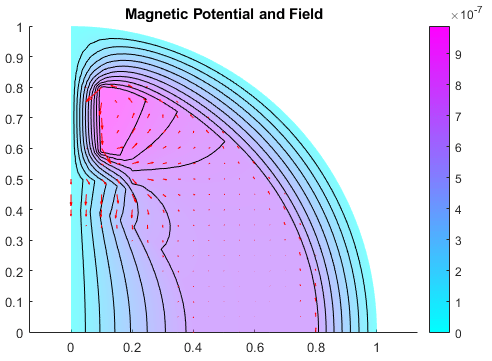Electromagnetics
In this workflow, you can only specify and store parameters belonging to electromagnetic analysis. To store all physical parameters for structural, thermal, and electromagnetic analyses, and for ease of switching between analyses types, use Unified Modeling. For help migrating your existing code to the unified finite element workflow, see Migration from Domain-Specific to Unified Workflow.
Solve PDEs that model static and time-harmonic electric and magnetic fields. A typical programmatic workflow for solving an electromagnetic problem includes these steps:
Create a special electromagnetic model container for an electrostatic, magnetostatic, or harmonic analysis.
Define a geometry and mesh it.
Assign electromagnetic properties of the material, such as relative permittivity, relative permeability, and conductivity.
Specify charge density, current density, and magnetization within the geometry.
Specify voltage, magnetic potential, surface current density, and an electric or magnetic field on the boundaries.
Specify absorbing boundary conditions.
Solve and plot results, such as the resulting electric or magnetic potentials, fields, and flux densities.
Functions
Live Editor Tasks
| Visualize PDE Results | Create and explore visualizations of PDE results in the Live Editor (Since R2022b) |
Objects
ElectromagneticModel | Electromagnetic model object (Since R2021a) |
ElectrostaticResults | Electrostatic solution and derived quantities (Since R2021a) |
MagnetostaticResults | Magnetostatic solution and derived quantities (Since R2021a) |
HarmonicResults | Harmonic electromagnetic solution (Since R2022a) |
ConductionResults | DC conduction solution (Since R2022b) |
Properties
| ElectromagneticMaterialAssignment Properties | Electromagnetic material properties assignments (Since R2021a) |
| ElectromagneticSourceAssignment Properties | Electromagnetic source assignments (Since R2021a) |
| ElectromagneticBCAssignment Properties | Electromagnetic boundary condition assignments (Since R2021a) |
| PDESolverOptions Properties | Algorithm options for solvers |
| PDEVisualization Properties | PDE visualization of mesh and nodal results (Since R2021a) |
Topics
Electrostatic and Magnetostatic Problems
- Electrostatic Potential in Air-Filled Frame
Find the electric potential in an air-filled annular quadrilateral frame.
Electromagnetic Equations
- Electrostatics and Magnetostatics
Partial differential equations for electrostatics and magnetostatics problems. - DC Conduction
Partial differential equations for direct current electrical conduction problems. - Harmonic Electromagnetics
Partial differential equations for time-harmonic electromagnetic fields.

